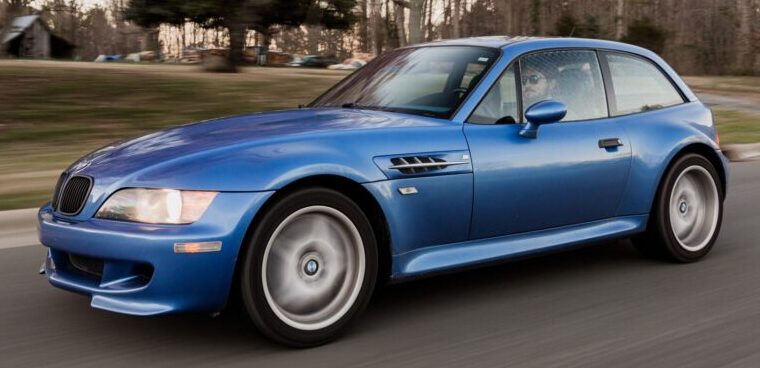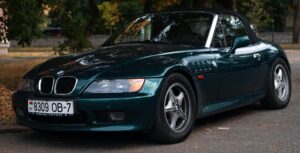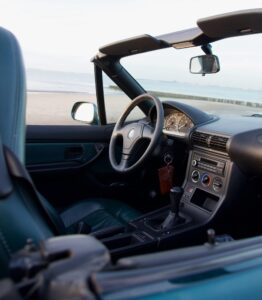Will the BMW Z3 become a future classic car?
2. Later models
3. BMW Z3 price
4. Will the BMW Z3 be a future classic?
Production BMW Z3
Will the BMW Z3 become a future classic car? The BMW Z3 is a compact luxury sports car that was produced by BMW from 1995 to 2002. It marked a significant point in BMW’s history as it was the company’s first modern mass-produced roadster. The Z3 was introduced as a response to the rising popularity of compact sports cars, and it played a role in reinvigorating interest in roadsters during that era.
The Z3 was notable for its design, which combined classic roadster elements with BMW’s modern styling cues. It gained initial fame through its appearance in the James Bond film “GoldenEye,” further contributing to its popularity.
The Z3 was manufactured at BMW’s plant in Spartanburg, South Carolina, USA. It was available with a range of engines, including four-cylinder and six-cylinder options. The early models featured a 1.9-liter four-cylinder engine, while later models offered more powerful engines such as the 2.3-liter and 2.8-liter six-cylinder engines.
The success of the Z3 paved the way for its successor, the BMW Z4, which continued the tradition of compact luxury roadsters in BMW’s lineup. The Z3’s production ceased in 2002, but its impact on the automotive world and its role in BMW’s history are still remembered by enthusiasts and collectors today.
Later models
The BMW Z3 underwent a facelift in 1999, resulting in what is often referred to as the “E36/7/8” generation of the Z3. This facelift brought about several changes to the design, features, and mechanical components of the car.
Design-wise, the later models featured updated styling elements. The front and rear fascias were revised, giving the Z3 a slightly more modern and refined appearance. The headlights and taillights were also updated to align with BMW’s design language at the time.
Mechanical improvements were made as well. The range of engines was expanded to include more powerful options. The base 1.9-liter engine was joined by a 2.3-liter inline-six engine and a more potent 2.8-liter inline-six engine. These engines offered increased performance over the earlier models.
Inside the cabin, there were enhancements to comfort and convenience features. Depending on the trim level, options like leather upholstery, automatic climate control, and advanced audio systems were available.
The later BMW Z3 models retained the roadster and coupe body styles. The Z3 Coupe, in particular, gained a unique and distinctive appearance with its shooting brake-like design, which set it apart from the traditional roadster look.
BMW Z3 price
The price of a BMW Z3 can vary widely based on several factors, including the model year, condition, mileage, trim level, optional features, and the overall demand for the particular configuration.
When the BMW Z3 was new and being sold by dealerships, the price would have varied based on the factors mentioned above. The base price of the earliest Z3 models, such as the 1996 model year, was around €23,000. However, this price could increase significantly with added options and higher trim levels.
As the years went by, newer model years and updated versions were introduced, potentially affecting the price range. Additionally, the special editions, more powerful engines, and unique features could also influence the pricing.
In the used car market, the price of a BMW Z3 will depend on its condition and mileage. As of my last update in September 2021, you could find used BMW Z3 models starting from a few thousand euros for older, higher-mileage models that might require more maintenance. On the other hand, well-maintained, low-mileage examples of later model years or special editions could command significantly higher prices, potentially reaching into the tens of thousands of euros.
Will the BMW Z3 be a future classic?
The BMW Z3 has all the makings of a potential future classic. While it’s not possible to predict the future with certainty, there are several factors that contribute to its potential as a classic car:
- Cultural Significance: The BMW Z3 gained significant cultural visibility when it appeared in the James Bond movie “GoldenEye” in 1995. This exposure helped solidify its place in pop culture and could contribute to its desirability among collectors.
- Pioneering Roadster: As one of BMW’s first modern mass-produced roadsters, the Z3 played a role in reviving interest in compact sports cars in the 1990s. Its design and driving experience make it a symbol of a specific era in automotive history.
- Distinctive Design: The Z3’s design combined classic roadster aesthetics with BMW’s signature styling cues. This unique blend could make it stand out among future classic cars.
- Limited Production: While the Z3 was produced for several years, its production numbers weren’t extremely high, especially compared to more mainstream models. Limited availability can increase a car’s desirability as it ages.
- Enthusiast Following: The Z3 has a dedicated enthusiast community that appreciates its driving dynamics, design, and heritage. Enthusiast support often contributes to a car’s longevity as a collectible.
- Convertible Appeal: Convertible models tend to have a special place in the world of classics, as they offer a different driving experience and embody the joy of open-top motoring.
- Increasing Rarity: With time, the number of well-preserved Z3 models is likely to decrease, potentially driving up demand for the remaining examples.
While these factors point to the BMW Z3’s potential as a future classic, it’s important to remember that classic status isn’t guaranteed. It depends on continued interest from collectors, cultural relevance, and the evolution of automotive trends. If you’re considering a BMW Z3 as a potential investment, it’s advisable to choose a well-maintained example with desirable features and specifications.
Are you already a proud owner of a BMW Z3? If so, check out our selection of parts for this car at the following link:
https://octoclassic.com/product-category/bmw/z3











